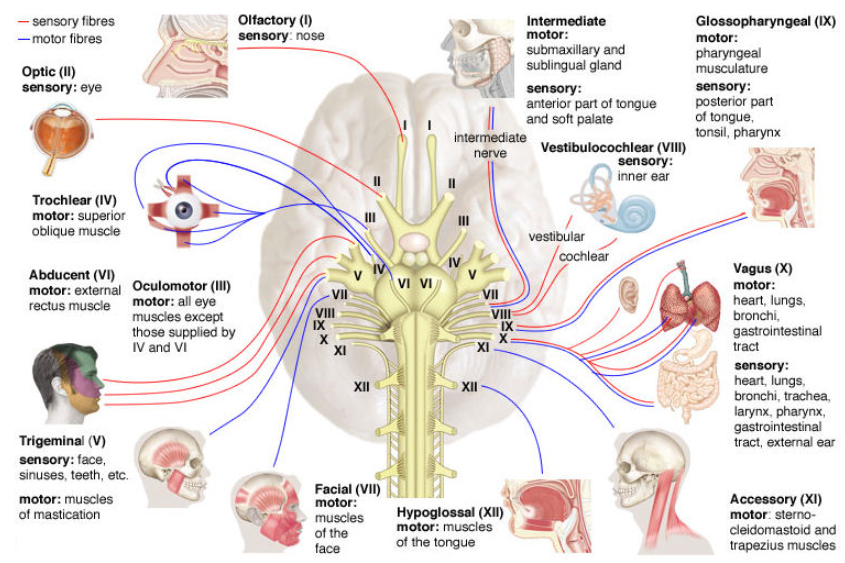脳と報酬系
コラム
その経歴を通して、今日の脳科学の基礎となる脳外科学のみならず、今日に至る神経科学の発展に多大な貢献をした。てんかんの外科治療の先駆者であるとともに、脳外科手術時に全身麻酔を行わず、切開部の局所麻酔で行った。脳そのものには痛みを含む感覚受容体がないためこのような術式が可能である。この術式を用いると手術中も患者に意識があるため、大脳皮質の電気刺激による脳局所の機能同定を行なうことができ、疾患のある脳領域の切除部決定をするにあたって、機能保存すべき大脳皮質領域の決定が可能になった。世界的に麻酔の安全性を優先させるため脳外科手術も全身麻酔で行われるようになったため、このような術式は行われることが少なくなったが、最近になって麻酔全般の安全性向上にともなって復活してきている。
脳の中のこびと
アメリカの脳神経外科医のワイルダー・グレイヴス・ペンフィールド博士(1891-1976)は、てんかん患者を治療しながら、脳が体を知覚する方法の理解を深める研究を行いました。脳半球のそれぞれには2つの地図が広がっています(ペンフィールドの地図とも呼ばれます。)
1つは運動の地図で、私たちの動きを操作する場所です。もう1つは感覚の地図で、体の感覚情報が処理されている場所です。左図の小人(ホムンクルス)は、その地図を立体的な人形にしたものです。図を見ると、脳がどのように体を見ているのかが見えてきます。
脳から直接出てくる特別な12対の神経があります。これらの中には、目、耳、鼻、口からの感覚情報を伝達するものや、頭や喉の筋肉を制御するものなどがあります。心臓や肺のような重要な臓器や様々な腺へ供給するものもあります
- 報酬系(ほうしゅうけい、英: reward system)とは、ヒト・動物の脳において、欲求が満たされたとき、あるいは満たされることが分かったときに活性化し、その個体に快の感覚を与える神経系のことである。
ここでいう欲求には、喉の渇き・食欲・体温調整欲求といった生物学的で短期的なものから、他者に誉められること・愛されること・子供の養育など、より高次で社会的・長期的なものまで含まれる。認知心理学者は、ヒトにおいてはむしろ後者の欲求の方が、行動の決定に重要な役割を果たしていると主張している。
哺乳類の場合、報酬系は中脳の腹側被蓋野から大脳皮質に投射するドーパミン神経系(別名A10神経系)であると言われている。これは、覚醒剤やコカインなど依存性を有する薬剤の大部分は、ドーパミン賦活作用を持っていることからも支持される。また、動物において中脳に電極を挿入し、その個体がボタンを押すと電流が流れるような装置を作ると、とめどなく押し続けるという報告もある。
報酬系の働きは、学習や環境への適応において重要な役割を果たしている。例えば我々は、「この仕事を完了したらボーナスがもらえる」などと、長期的な報酬を予測することで、疲労や空腹といった短期的欲求を抑えて仕事を優先できる。しかし当てにしていたボーナスがカットされると、報酬系が抑制され、不快さを感じるのである。また、報酬系神経系の働きが、大脳皮質の可塑性に影響するという報告もあり、学習においても同様に報酬系が重要である。「誉めて育てる」という言葉はこのことを言い得ている。
報酬系が活性化するのは、必ずしも欲求が満たされたときだけではなく、報酬を得ることを期待して行動をしている時にも活性化する。例えば、喉が渇いているヒトが水を飲んだときには、脳内で報酬系が活性化し快の感覚を感じる。しかし、ヒトであれば歩いている途中に自動販売機を見つけた場合、その時点で水分が飲めることが当然推測できるので、見つけた時点で報酬系が活性化している。これに似たような実験をシュルツら(1993)がサルにおいて行っている。彼らは、ある視覚刺激を呈示して数秒後にエサが出てくるという装置を作り、サルをそれに馴れさせた。同時に中脳のドーパミン系細胞に電極を挿入し活動を記録したところ、実験初期にはエサが出てきた時点で細胞が活性化していたが、実験に馴れて来ると、視覚刺激が呈示された時点で神経活動が活性化していた。 - 変性意識状態
Brain and reward system
column
Wilder Penfield
Through his career, he has made a great contribution not only to the development of neurosurgery, which is the basis of today’s brain science, but also to the development of neuroscience to this day. He was a pioneer in the surgical treatment of epilepsy and did not undergo general anesthesia during brain surgery, but with local anesthesia at the incision. Such a procedure is possible because the brain itself does not have sensory receptors including pain. Since the patient is conscious during surgery using this procedure, it is possible to identify the function of the local brain by electrical stimulation of the cerebral cortex, and the function should be preserved when determining the excision site of the diseased brain region. It has become possible to determine the area of the cerebral cortex. Since brain surgery is now performed with general anesthesia in order to prioritize the safety of anesthesia worldwide, such surgical procedures are rarely performed, but recently it has improved the safety of anesthesia in general. It has been resurrected with it.
Dwarf in the brain
Dr. Wilder Graves Penfield (1891-1976), an American neurosurgeon, conducted research to better understand how the brain perceives the body while treating patients with epilepsy. Each of the hemispheres has two maps (also known as Penfield’s maps).
One is the map of movement, where we manipulate our movements. The other is the sensory map, where the sensory information of the body is processed. The dwarf (homunculus) in the figure on the left is a three-dimensional doll of the map. Looking at the figure, you can see how the brain looks at the body.
There are 12 pairs of special nerves that come directly from the brain. Some of these convey sensory information from the eyes, ears, nose, and mouth, and others control the muscles of the head and throat. Some supply important organs such as the heart and lungs and various glands.
The reward system is a nerve that activates in the human / animal brain when a desire is satisfied or is found to be satisfied, and gives the individual a sense of pleasure. It is a system.
The desires here are from biological and short-term ones such as thirst, appetite, and desire to regulate body temperature, to higher and social ones such as being praised by others, being loved, and raising children. Even long-term ones are included. Cognitive psychologists argue that in humans, the latter desire plays a more important role in behavioral decisions.
In mammals, the reward system is said to be the dopamine nervous system (also known as the A10 nervous system), which projects from the ventral tegmental area of the midbrain to the cerebral cortex. This is also supported by the fact that most of the addictive drugs such as stimulants and cocaine have a dopamine-activating effect. There is also a report that if an electrode is inserted into the midbrain in an animal and a device is created in which an electric current flows when the individual presses a button, the electrode is continuously pressed.
The function of the reward system plays an important role in learning and adaptation to the environment. For example, we can prioritize work by suppressing short-term desires such as fatigue and hunger by predicting long-term rewards, such as “you will get a bonus when you complete this work.” However, when the bonus that was relied on is cut, the reward system is suppressed and it makes me feel uncomfortable. There is also a report that the function of the reward system nervous system affects the plasticity of the cerebral cortex, and the reward system is also important in learning. The word “praise and grow” can say this.
The reward system is activated not only when the desire is satisfied, but also when the person is acting in the hope of getting a reward. For example, when a thirsty person drinks water, the reward system is activated in the brain and a feeling of pleasure is felt. However, if a human finds a vending machine while walking, it can be inferred that he / she can drink water at that point, so the reward system is activated at the time of finding it. Schultz et al. (1993) conducted a similar experiment in monkeys. They created a device that presents a visual stimulus and feeds a few seconds later, accustoming the monkeys to it. At the same time, when electrodes were inserted into dopaminergic cells in the midbrain and activity was recorded, the cells were activated when food came out at the beginning of the experiment, but as they became accustomed to the experiment, visual stimulation was presented. At that time, neural activity was activated.
Altered state of consciousness







